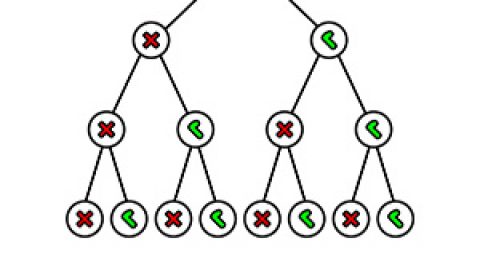It’s the Audience, Stupid
Five Christmases ago, I sat in my living room at 11:30pm, frustrated. An idiotic CD in my computer warbled out cheesy Christmas tunes while a bewildering jumble of pink plastic stared me in the face. I seriously wanted to take a baseball bat to Barbie’s Playhouse.
Today I can look back on that moment and smile.
That was the moment when I became a classic stereotype. I was officially a dad. I was one of those self-proclaimed pioneering spirits who didn’t need directions. I could see the picture on the front of the box. How hard could it be? I could fix that broken washing machine. Who needs a degree in electronics? I could find the public library without google maps. Who needs directions? It’s due west, two or three miles away. How hard can it be?
Ironically, it turns out there’s a parallel between dads and entertainment creators. Both seem to have arrived at the conclusion that things like directions, or process, are unnecessary. As long as you know what the end result should look like, how hard can it be?
What creative people eventually discover is that it’s far more difficult to create entertainment than it is to fix a washing machine or assemble a three story plastic dollhouse.
So with that in mind, I’ve set out to write some directions. I figure if I can save just one aspiring creator from experiencing the equivalent of a Christmas morning disaster, I can call it a win.
I’ll start with a piece of advice that should have some immediate impact… the big secret of entertainment.
Except I don’t know the answer. I only know the question:
WHO IS YOUR AUDIENCE?
I’ve talked with hundreds of writers and game designers over the years, and when the discussion drifts to ‘the concept’ (you know, the ten million-unit seller they’ve had lurking in the backs of their minds for the last decade), they get this dreamy, glassy-eyed look. That lasts a few seconds before some imaginary mental dam bursts, and then a tidal wave of details comes rushing out.
I try to listen patiently, but the babble-torrent doesn’t let up, so I eventually raise my hand and ask my question “Sounds fascinating. Can I ask who your target audience is?”
The flood of words dries up, and the vast majority of them raise one eyebrow, cock their heads to the side, and a big yellow question mark appears over their heads. They act as if they’ve never considered it.
And that’s a problem. A big problem.
Take a moment to mull this over. In fact, let’s do a little experiment. For purposes of the thought experiment, we’ll talk about videogame design, but the technique is identical whether you’re designing a game, writing a novel, or making a television show.
Imagine a fifteen-year-old boy. Let’s assume he’s a classic, hardcore computer gamer. He’s a cocky, smack talking, OCD know-it-all, who has a library of hundreds of games. He owns the latest versions of Playstation, X-box, and Nintendo. He likes aliens, watching explosions, seeing dragons breathing fire, and wizards shooting lightning bolts out of their butts.
That’s enough to get you started. Now take a couple of minutes and fill in some more details.
What genres of games does he like most? Which does he hate? What movies does he watch? What TV shows? What kinds of music? Books? What does he do with his spare time when he’s not playing games? How long will it be before he notices girls? How well does he do in school? What’s his favorite subject? Which subjects does he hate? In college, what will his major be? How many friends does he have?
Seriously, take a few minutes. Think about it. Come up with your own questions too.
Now, do you have a nice, clear picture of this kid?
Awesome. Now consider a fundamentally different audience. How about the so-called ‘soccer mom?’ This audience is a very fast growing market segment in the videogame world, so it’s worth considering.
What is she like? How old is she? How does she spend her time? What sorts of games does she like? What sort does she steer away from? What kind of subject matter does she enjoy? Does she like reality TV? Romance novels? Does she play games on a computer or a mobile device? What games does she play with her kids? What does she play alone? How long is a typical gameplay session for her? How many times per week? Does she like competitive games or social games? Again, create more questions, and take your time.
Fantastic. Have a clear picture of her?
Now try to imagine a game that both our soccer mom and the hardcore teen-age boy will absolutely love.
“Gee,” you say. “That’s hard. Really hard.”
Of course it is. They’re totally different people who have totally different lifestyles. Different tastes. Different life experiences, interests, likes, and dislikes. Things that a soccer mom finds offensive, the hardcore teenager giggles at. Things that the teenager thinks are dull or sappy might captivate the soccer mom. The same holds true for fiction, of course.
Actually, you can look at every single feature, character, or theme in any game, book, or television show, and measure it against the intended audience. What you’ll find is that when the features, the aesthetic, the story, the mechanics all appeal to the same specific person, then it’s often a successful work of entertainment. And when different features seem to be targeting different people, the effort is often a failure.
But that sounds a little abstract. Let’s consider a real example. How about a racing game?
To start with, they can be segmented into several broad categories. I’ll keep it simple and go with three:
- Tuners – hardcore simulations enthusiasts. For these people, it’s important to know whether the tire pressure should be higher on the left side of the car when racing on a counterclockwise track. They know the impacts on performance and mileage when the car uses overhead cams. They’re rabid fans of NASCAR and NHRA. They probably like to work on cars in real life.
- Hollywood Racers – This group prefers Fast and Furious over NASACAR. They don’t care about optimizing performance. They just want to push the gas pedal and go fast. They don’t need reality. Instead, they want their racing to have a dramatic feel.
- Mario Kart fans – The idea of competitive racing is fun, but it doesn’t matter if they’re racing go-karts, or dinosaurs, jet skis or snowmobiles. It doesn’t matter if the drivers are plumbers or turtles. Oil slicks and power-ups and anti-gravity jump ramps are all cool to this audience.
Each of these segments likes their version of racing, and tends to scoff at the other versions. Each is a specific audience with mutually exclusive expectations and tastes.
Read that mutually exclusive phrase again. Yes. It means you can’t mix them.
Go ahead. Try making a racing game for the tuner fans. After letting them assemble their dream vehicle in the virtual garage, put a turtle behind the wheel. During the race, have the turtle pressing buttons that splash oil slicks on the track behind the car. Once you ship the game, watch the vitriol light up the chat forums. Watch your sales tank. It’s not pretty.
And it works the same way for fiction. Let’s take a genre like Sci Fi. That seems pretty straightforward, right? Nope. There are tons of different sub-genres of SciFi, including Cyberpunk, Christian Science Fiction, Sci Fi Thrillers, Military Science Fiction, Steampunk, Transrealism, etc. Each and every genre has it’s own audience with their own needs and expectations.
The hardcore Sci Fi fan wants ironclad science. They will question every detail for plausibility, and if they find your story lacking, they’ll drop it like a hot rock. In contrast, the Sci Fi Romance genre MUST have a love story. The Military Sci Fi MUST have fancy weapons and/or gadgets.
Each subgenre has it’s requirements. We know this, but how often do we connect the dots from the genre requirements to the audience itself?
Every piece of entertainment has an audience. A specific audience. If you know exactly who they are, you have at least a chance of capturing their attention. But the less you know about them, the more likely you are to do something that they not only won’t find entertaining, they might actually be repelled by.
This is the part where my conversation partner occasionally brightens up and says something like “Oh, so you want to talk about my demographics? Sure. I know who they are. My audience is an 18-35 year old, middle class, white male.”
Gee. That’s quite possibly the most worthless information ever.
Look. There was a time, maybe fifty years ago, when socioeconomic homogeneity allowed for marketers to make sweeping generalizations about large segments of the population. Similar family life and economic conditions resulted in very little variation in people’s personalities and tastes.
Those days are over.
Today, people have instant access to information and cultures that was unheard of in previous generations. And that access has caused massive fragmentation in the marketplace. There are countless micro-niche segments, and even the broader categories have multiple facets and sub-categories. Broad generalizations are meaningless now.
Whenever I hear that whole 18-35 year old middle class white male garbage now, I show people a collection of photos I’ve gathered. They are all 18-35 year old, middle class, white males, but they come from vastly different walks of life. There are soldiers and rednecks, businessmen, frat boys, farmers, hipsters, skaters, activists, scientists, artists, and athletes. The only thing they all have in common is that they are 18-35 year-old, middle class, white males. I invite people to take a good look at each one and speculate on their personalities and then tell me with a straight face that they will all be entertained by the same movies, books, music, or computer games.
Clearly not.
What we need is something more granular than the old-school demographics. Enter: psychographics.
What is a psychographic? It’s a way of studying population groups according to their attitudes, aspirations, values, habits, hobbies, spending habits, opinions, fears, lifestyles, and other psychological criteria. It’s a way of trying to do more than simply identify a customer. It’s a means of understanding them. Put succinctly, the old metric, demographics, explained who the customer is, while the new metric, psychographics, explains why they prefer a particular kind of product.
Let’s take a look at a couple of examples from middle class white males to better illustrate the point. First, we’ll start with a classic skater. In order to think about him as a more complete person, let’s give him a name: Tyler.
—
Tyler: Tyler leads an active, athletic life. He’s into snowboarding, skateboarding, and extreme sports. His preference for outdoor activities means that videogames and reading fiction are generally not at the top of his list of things to do. He owns a laptop and knows how to surf the web, but to him technology is a tool, not a passion. When he watches television, it’s usually sports, not movies. When he does watch a movie, he streams the video from Netflix, preferring action movies and martial arts films.
Tyler is an adrenaline junkie. He likes taking risks personally, everything from skydiving to bungee jumping. Similarly, he enjoys fictional tropes involving death-defying stunts.
When playing computer games, his inherently physical nature drives him towards mechanics that lean heavily on physical skill (reflexes, hand-eye coordination), without a great deal of emphasis on strategy or story. The kind of story he requires features characters with physical skills rather than weapons, and is set in semi-believable contemporary locales. Films like xXx and Fast and Furious are in the right style.
Tyler dislikes spectating, unless it is for the purposes of evaluating future opponents. He would prefer voice chat to typing, and needs opportunities to show off and demonstrate his successes. He listens to music like Black Flag, Offspring, Sublime, K.M.K, etc. His favorite retro game is SSX Tricky.
—
The information here is far more valuable than demographic data. It tells us what sorts of genres will work for this audience, as well as fictional tropes, game mechanics, themes and tones, and even gives us ideas of musical style. Armed with enough of this kind of information, quite a few significant decisions in the brainstorm process are literally made for us.
Additionally, this sort of profile also helps steer us away from potential pitfalls. If we know Tyler is our target audience, then we won’t waste time producing highly complex story or cinematics, nor will we include such common game features as levelling systems. In games, Tyler prefers systems that lean on his own physical prowess, not some arbitrary level that requires nothing more than playing a sufficient number of missions, or earning imaginary experience points. In fiction, he wants simple, straightforward story that dwells on characters with realistic physical skills, rather than depending on James Bond-style gadgets.
If I were designing a game for Tyler, I’d place more emphasis on animation quality than polygon counts or pixel density. Tyler is a physical person, so fluid, crisp, realistic motion will resonate with him. I’d also favor interesting camera angles and sound effects over highly detailed particle effects or lighting. Again, things like vantage point and sound appeal to the concrete and physical nature, more effectively than imaginary explosions or blood spatter sprites.
If I were writing a book for him, it would undoubtedly feature a protagonist who was into mountain climbing or parkour. I’d research the proper terminology for these physical activities, since Tyler knows these details like the back of his hand. You can get science and technology wrong with Tyler as your audience, but you’d better know a tic-tac from a double kong, or you’re in trouble.
Further, since we have a better idea for Tyler’s lifestyle, then our marketing department will have a better idea of where to reach him. Tyler isn’t the kind of audience who will ever see advertisements in gaming magazines or book clubs. It would be more effective to search for him through customized Google ads, in sponsorship ads for extreme sporting events, or in specialty magazines like Uberdog Magazine, X Sport, or No Limits.
This is a gold mine of valuable data.
Let’s look at another example. This time we’ll go with a beer drinking, rather offensive redneck. We’ll call him Vince:
—
Vince: Vince is a self-defined macho man. Slightly paranoid, vaguely sadistic, and/or a bit of a misogynist. He prefers male protagonists, distrusts the government, and prefers themes involving aliens, extreme violence, professional wrestling, conspiracies, or NASCAR. Vince needs bogeymen, or someone to truly despise. He considers medieval fantasy to be ‘fruity’.
Vince views the world through a very black-and-white filter; there are no moral gray areas. He prefers direct, in-your-face, uncomplicated stories and mechanics. He is highly competitive, and likes to insult people when he beats them. He dislikes overly cerebral themes. He listens to southern rock, country, and some 80’s-90’s bands.
With videogames, Vince prefers solitary games over co-ops, and will generally only accept groups when he knows the other players personally. He doesn’t make new friends easily, and when forced into groups, he eschews leadership and leaders both, often acting as a loose cannon or lone wolf. When the team loses, he will blame everyone around him. With books, his tastes run towards anti-heroes, especially when they epitomize anti-establishment.
—
Again, there is a wealth of information for us to work with as creators. But my use of Vince as an example here also serves a second purpose. Vince is a thoroughly unlikable person. Not many people would seek out Vince when looking to make a friend. In fact, I know a lot of people who would refuse to create entertainment for Vince at all, purely because he’s an asshole, and they don’t want to design for assholes.
I think we fall into a dangerous trap when we adopt that attitude, however. When we allow ourselves to judge our audience, we lose our sense of objectivity. If we allow ourselves to boycott audiences like Vince, we might just find ourselves making cases against designing entertainment for kids, or women, or people less intelligent, or from foreign countries or different ethnicities. It’s a slippery slope. I think most writers and videogame designers would balk at trying to entertain Vince, but use the example as a thought experiment. It’s only a mental exercise. You don’t have to do it for reelz.
It’s a valuable skill for a creator to be able to step into the audience’s shoes and see the world through their filters. You don’t have to emulate them or even like them as a person. But to entertain your audience, you do have to be able to see the world through their filters without judging them.
Making entertainment isn’t about what you personally find cool, or interesting, or sad, or funny. It’s about what your audience thinks is cool, interesting, sad, or funny. When you can learn to successfully channel your audience, you are taking the first steps towards entertaining them.
As a matter of practice, I advise people to perform this thought experiment repeatedly. Make a study of different kinds of audiences. Choose people who are totally unlike you. Learn to get inside their heads and, in a non-judgmental way, try to figure out what makes them tick. Learn to walk a mile in their shoes, understand what makes them laugh, cry, or get their hackles up. You don’t have to agree with their values or attitudes. You just have to understand them.
As a side note, while this article is about crafting an entertainment experience for a target audience, the exact same methods hold true for creating believable characters. If you judge your characters, you’ll make them less plausible by virtue of the fact that your dislike of them will cause you to describe them in exaggerated, cartoonish ways. Almost no characters should actually view themselves as evil or stupid. They have their ways of thinking, and their actions seem justified to them. That’s the way you should write them. Walk a mile in their shoes. Give plausible reasons for why the do what they do and say what they say. Force yourself to make them seem reasonable in some way. The results will show in your writing.
As a final example, I’ll provide the notes on my intended audience for Gnosis. This audience is a 15-20 year-old female member of Generation K. We’ll call her Jennifer.
—
Jennifer
Research into that audience suggests that having grown up in the era of 9-11 and the economic meltdown of 2008, they differ somewhat from typical millennials. They are pragmatic, more accepting than typical millennials of things like US military presence overseas and rigid security and police tactics. They frequently eschew conversations about marriage and children, instead emphasizing the need to establish themselves and their careers first. As such, I don’t believe a strong romance component is needed, or even perhaps desired in Gnosis. The audience wants a resilient, self-sufficient, adventurous female protagonist, who isn’t afraid to roll her sleeves up and step into conflict. That said, she doesn’t want to see an implausible ninja girl beating the crap out of huge men. My audience are realists. They want believable-but-decisive action. Typical traits of generation K are:
- Very connected and acclimated to technology
- Shaped by a life of job insecurity, rampant inequality, and fear of the economic future
- Have almost no historical sense of where technology came from
- They see the world as a fairly dystopian place
- Unlikely to use drugs or alcohol as much as previous generations
- Intent on working hard, as hard as it takes, to succeed
- Distrusts government and corporations, don’t care for social institutions. 30% of Gen K females have no desire to get married. 35% don’t want children. Girls feel like they can’t “have it all”, and security is more important than building a family
- Strong sense of “right” and “fair”
- Traits include: anxiety, generosity, loneliness and isolation, creativity, pragmatic, strong sense of community.
—
Again, we have a lot of actionable information to work with. Using this description, I tried to work in themes, details, and affect that I hoped would resonate with the Generation K female audience. The technique operates as a kind of razor, letting you know that even if an idea sounds cool, it might not work for your specific audience.
As a final thought, sometimes content creators ask me “This is great, but how can I find this kind of information?”
It’s a good question. And the best answer is to find a real person (or better yet, a few) who represent your target audience. Interview them. Ask them questions. Get to know them. If you have several people to interview, so much the better. Construct a composite person, and use that as your target. Make this character rich, detailed, and three-dimensional.
And when you know them well enough, then and only then should you start creating entertainment for them.










